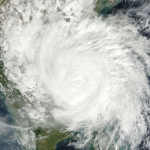Blog Details
Hurricane Preparation.
With sizes that can span more than 300 miles, hurricanes have become one of the most dreaded natural phenomena on the East Coast. In the past ten years, a great deal of investment from national, state, and non-governmental platforms has gone towards preparation efforts. To simplify the process, we've compiled some of our most prudent advice. What's the difference between Hurricane Watch and Hurricane Warning? Hurricane Watch Weather centers will issue a hurricane watch when it becomes possible for hurricane conditions to manifest in as little as 2 days. This may often be the first sign of atmospheric changes following tropical storm watches. Hurricane Warning This designation is issue to a specific area when it becomes expected that hurricane conditions will most likely manifest within 36 hours. How do you prepare? 1. Check that you're covered by your insurance. Account for both water damage, flood damage, structural damage, personal property 2. Account for all valuable items in your home 3. Protect your property by effectively securing loose exterior fixtures and installing protective equipment, such as shutters 4. Ensure that all emergency supply kits in your home have been properly stocked and that you have ice packed in your fridge 5. Plan your evacuation completely; including routes, supplies, mode of transportation, and finances Recommendations for Supply Kits 1. Enough water for you and your family for at least 3 days. A standard metric for preparation is one gallon per person per day. 2. A proportional supply of non-perishable food for 3 days 3. Battery powered or hand crank radio 4. First aid kit with bandages, thermal blankets, glow sticks, sterile gloves, anti-septics, etc. 5. Flashlights and extra batteries 6. Duct tape 7. A whistle in case help needs to be indicated 8. Plastic sheeting 9. Tools, such as wrenches, pliers and hammers 10. Plastic bags and plastic ties 11. Moist towelettes 12. Non-electric can opener 13. Local maps 14. Cell phones with chargers, battery packs and solar chargers 15. Candles 16. Electric cooking wear When do you evacuate? Evacuate ahead of time with plenty of space between you and the storm Leave when authorities issue a mandatory evacuation Evacuate if you have no means of fortifying your home with protective fixtures Things to do before you evacuate 1. Be prepared to drive at least 50 miles and away from the coast 2. Pack emergency supplies 3. Prepare maps 4. Inform a friend or family of your destination or route 5. Turn off the gas, electricity and water in your home 6. Empty the refrigerator or freezer 7. Prepare home for possible water damage by securing valuables on higher ground If you can't evacuate 1. Stay close to home 2. Stay aware of weather updates 3. Stay inside when the storm is closer or present 4. Stay away from windows and glass with all curtains and blinds closed 5. Close all interior doors to stifle potential air flow 6. Take refuge on the lowest level of the home unless the home floods 7. Do not exit in the eye of the hurricane 8. Turn off main circuit of home if electricity goes out 9. Avoid the use of candle supply behind closed doors- reserve those for lighting outdoors after the storm What do you do after a hurricane? 1. Turn on the radio for weather updates 2. Return home from your evacuation destination only when authorities indicate that it is safe 3. If your home or area experienced flooding, be cautious of standing water- which may hide snakes and poisonous insects. 4. Check for gas leaks if you hear a hissing or blowing noise 5. Do not enter buildings if structural damage is evident. Stay away from con-caving ceilings. 6. Ventilate home by opening windows 7. Do not use open flames- verify the absence of a gas leak 8. Do not drink tap water until instructed otherwise 9. Reactivate the gas in your home if it was shut off 10. Stay away from electrical infrastructure and downed power-lines Making a claim after the storm 1. Contact your coverage provider and speak to your agent 2. Document all damage with photos 3. Document all efforts to make temporary repairs- keep all receipts 4. Schedule an inspection Resources: www.flash.org www.redcross.org www.nhc.noaa.gov











Let’s Get in Touch
Your email address will not be published. Required fields are marked *